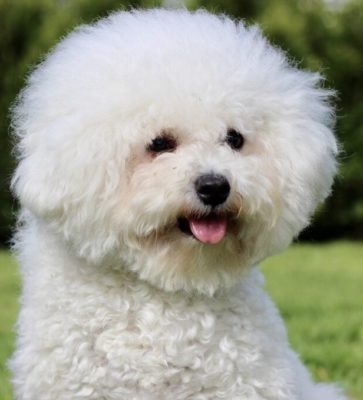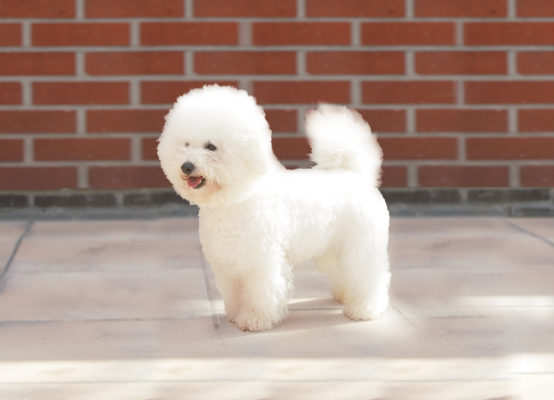Bichon Frise

The Bichon Frise is an ornamental dog breed that is great as a pet. They are kind, gentle, and affectionate and love to be the center of attention. Pets of this breed are rarely seen as angry and aggressive. They are cheerful and playful, and their eyes are almost always filled with amusement.
Table of Contents
Breed Information
| Another Name | Bichón Tenerife, Bichon à poil frisé |
| Origin | Canary Islands (Spain), Belgium/France (later development) |
| Height | Males 25-30 cm Females 23-27 cm |
| Weight | 3-5 kg |
| Fur | Medium |
| Color | White |
| Lifespan | 14-15 years |
| FCI Classification | Companion and Toy Dogs |
| Group | Hypoallergenic dogs, apartment dogs, small breed dogs or decorative dogs |
| Price | From $300 |
Breed Photos
Origin History
The Bichon Frise is a small French dog breed, also called the French Bolonka. The first mentions of small puppet dogs of this breed date back to about the XII century. There is a version that the ancestor of the modern Bichon Frise is the island of Tenerife. This breed was highly valued by the island’s sailors, who used lapdogs for catching rodents on the ships. They called it “Tenerife Bichon”.
As their popularity grew, they were noticed by aristocrats in Spain, Italy, and France and were always carried with them for beauty, image, and status. The Bichon Frise leaves no one indifferent. In the XIII century, the Bichon Frise became known among the royal courts of several European countries.
After the French Revolution outbreak in 1789, the little Bichon Frise started to lose its privileges and eventually lost its status as a “royal dog”. One by one, their owners were sent to detention places, and the pets themselves were thrown out into the streets, where street performers or ordinary peasants picked them up.
Legend has it that street performers noticed these little white dogs’ dexterity and intelligence and taught them all sorts of tricks to lure passersby for a coin. After a while, these French dogs became circus performers, where they were always the center of attention.
In the twentieth century, the Bichon Frise was on the verge of extinction. Due to the crisis caused by the two world wars, the breed was left on the streets. Thanks to a few admirers of the breed, who collected little bichons on France and Belgium’s streets, it was saved.
Appearance
The Bichon Frise is a small, fluffy lump with a doll face, making it a very attractive breed. Predominantly the Bichon Frise has a white coat color, but sometimes cream or pale yellow coats are found in puppies. The attractive light-colored curls of the French Cologne are cotton-like, with a black nose and dark eyes flashing in the background.
Despite the peculiarities of this breed’s coat, they are not prone to abundant shedding, so they are sometimes recommended for dog lovers who suffer from allergies. It is because of this that the Bichon Frise is referred to as the group of hypoallergenic dogs.
The high-curved neck of the Bichon Frise gives it a confident and proud look. The dog’s tail, like its body, is covered with thick, abundant hair. The bichon’s elevated tail indicates that he is in a cheerful and playful mood.
Due to their small size, French Lapdogs are pets that are great in apartments. They can become a good friend and melt the heart of anyone who previously had no idea that dogs can be so kind and lovable.
Character
The Bichon Frise is an ornamental dog breed that is great as a pet. They are kind, gentle, and affectionate and love to be the center of attention. Pets of this breed are rarely seen as angry and aggressive. They are cheerful and playful, and their eyes are almost always filled with amusement. Lapdogs are friendly and usually get along well with other animals and people, but they may alert their owner at the sight of a stranger. Their deep bark aids it.
The Bichon Frise does not like to be left alone for long periods and suffers from its owner’s long separation. These Bolon dogs not only like to be with their families, but they also need it. Therefore, people who have to leave their pets home alone often and for long periods should not get a French Lapdog.
The Bichon Frise is a breed with good intelligence and intelligence. At the same time, they do not like to concentrate on one thing for a long time and show their cheerful and energetic character at every opportunity.
Care
Since Bichons Frise are white, fluffy curls owners, they need to be brushed out daily and cut regularly. Haircutting a Bichon Frise will require a bit of knowledge; in particular, you need to be aware of the importance of removing hair from the ears. It will allow the ears to “breathe” and help reduce the risk of ear problems.
It is recommended to check the eyes daily, clean them of tear deposits, brush the teeth once a week, and trim the claws several times a month. French Bolos should be washed about once a month using a mild shampoo for fluffy coats.
Training
Bichons Frise is an intelligent dog who loves to learn tricks and commands, but only if the training is not monotonous and boring. In general, Bichons Frises are trainable, obedient, and like to please their owner, but that’s not to say that training will be easy.
In training, it is very important to be persistent and not show aggression towards the pet. The displays of aggression can hurt the little lapdog’s heart so much that they will categorically refuse to respond to the owner’s commands and will ignore them.
Representatives of this breed do not need much exercise. It is recommended that most adult dogs be provided with active outdoor walks of about an hour.
Common Diseases
With proper care and regular preventive examinations at the veterinarian, Bichon Frise dogs’ health is quite strong. The average lifespan of these dogs is 12-15 years.
Bichons Frise, more than other dogs, are susceptible to various ear diseases. Ears can become irritated by grass and dust on walks, mites, and other parasites. It leads to otitis media, an inflammation of the ear canal.
Because it causes intense itching, your dog will start to twist his head and flap his ears, which signals the need to visit the vet.
The skin of the Bichon Frise can also be affected by many diseases. Like many other furry breeds, the Bichon Frise is prone to allergies that lead to dermatitis. Since allergies cannot be cured, your pet’s skin condition should be monitored throughout life.
In addition to ear problems and allergies, pets of this breed can be diagnosed with diseases such as tear duct deformities, urolithiasis, epilepsy, and diabetes.
Nutrition
Since Bichons Frise does not need much exercise, it is important not to overfeed these pets. Their diet should consist of quality foods that are suitable for this breed.
Whether to feed your dog dry food or natural products is the owner’s prerogative. If the owner decides to feed dry food, it should be premium food. If natural food is chosen, it is important to include raw meat in the Bichon Frise’s diet, which can be treated with boiling water before serving it to the dog. Also, Bichon Frise can be fed boiled or raw vegetables, boneless fish, buckwheat, or oatmeal porridge. It is not recommended to include spicy and too salty delicacies in the diet of this Bichon Frise. Dairy products are acceptable in the diet of a small puppy.
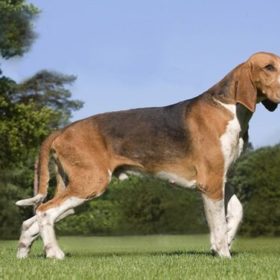 Grand Anglo-Français Tricolore
Grand Anglo-Français Tricolore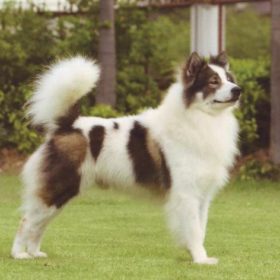 Thai Bangkaew Dog
Thai Bangkaew Dog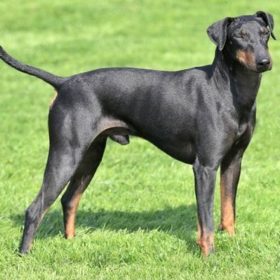 Manchester Terrier
Manchester Terrier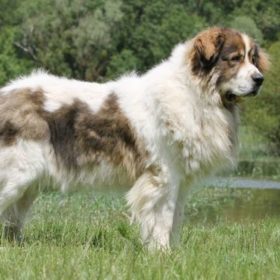 Pyrenean Mastiff
Pyrenean Mastiff West Siberian Laika
West Siberian Laika Shar Pei
Shar Pei
